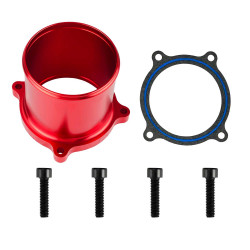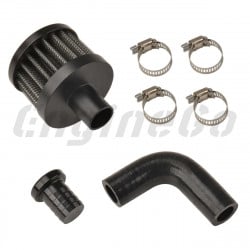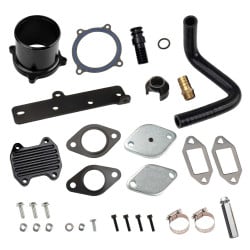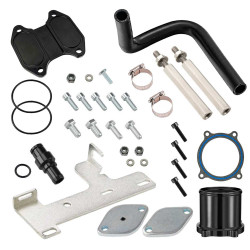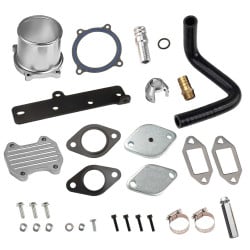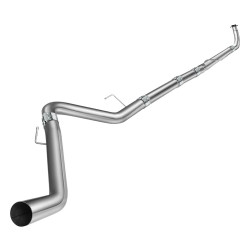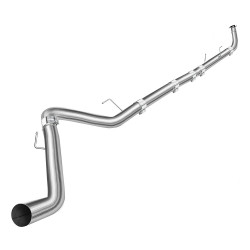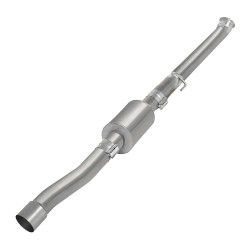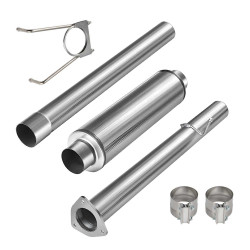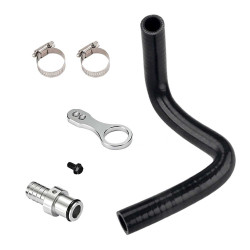Introduction to the Post-2013 6.7L Ram Cummins
The 6.7L Cummins diesel, introduced in 2007, replaced the 5.9L with 13% more displacement and modern tech like common-rail injection and a variable-geometry turbo. To meet stricter emissions, it added EGR and a DPF system, with SCR/DEF introduced in 2013–2014 for better fuel economy and torque. Power ranges from ~350 hp in early models to 420 hp and 1,075 lb-ft in newer high-output versions, making it a durable choice for heavy-duty work.
Owners use post-2013 6.7L Cummins trucks in a variety of heavy-duty roles:
- Towing: These Cummins engines are built for hauling. High-output 3500HD models can tow class-leading loads (up to ~30,000 lbs in properly equipped rigs), making them a favorite for commercial trailers, campers, and heavy machinery.
- Commercial and Fleet Use: The 6.7L is common in construction, farming, and contractor fleets. Its strong low-end torque (often 650–900 lb-ft) makes light work of hauling payloads and equipment.
- Off-Road and Recreation: Many owners use 6.7L Rams for off-road hauling (campers, ATVs, boats) and in rugged environments. The engine’s broad torque curve and robust cast-iron block help it withstand high mileage and continuous use.
From 2007.5 to 2024, the 6.7L Cummins steadily increased in output—from ~350 hp/610–650 lb-ft early on to ~420 hp/1,075 lb-ft in recent high-output models. The 2013 addition of SCR/DEF boosted power, especially in HD variants. Overall, 2013–2024 models range between 350–420 hp and 650–1,075 lb-ft, depending on year and configuration.
Why 2013–Present 6.7 Cummins Owners Choose to Delete and Upgrade
While the 6.7L Cummins is fundamentally strong, many owners encounter issues related to its emissions equipment and design. In particular, the factory DPF (diesel particulate filter), EGR (exhaust gas recirculation) cooler, and CCV (crankcase vent) system can create headaches in real-world use. Key problems include:
- DPF Clogging and Frequent Regenerations: The stock DPF collects soot that must be burned off via periodic “regens.” Trucks used for short trips or towing at low speed often never reach full temp for passive regen. This forces frequent active regens (post-combustion fuel injection) to clear soot. Owners may see reduced fuel economy, long idle cycles, and warning lights. A fully plugged DPF can even trigger limp-mode. Moreover, a blocked DPF raises exhaust backpressure, which “strains the turbocharger” and causes turbocharger wear.
- Turbo/VGT Carbon Buildup: The 6.7L’s variable-geometry turbo (VGT) is efficient but can accumulate soot and oil vapor over time. Sticky vanes degrade spool-up and response. Combined with a clogged exhaust, the turbo must work against higher pressure, which can make turbo lag worse and potentially shorten turbo life.
- Oil Dilution / CCV Issues: Diesel blow-by (combustion gases past the rings) carries unburnt fuel and particulates into the crankcase. Over time, crankcase vapors condense into the oil, diluting its viscosity and creating acids/sludge. This accelerates wear on bearings, camshafts, and other internals. The OEM CCV setup recirculates some of this oil mist back through the intake, fouling the intercooler and intake tract.
- EGR Cooler and Valve Failures: The EGR system reintroduces hot exhaust into the intake to cut NOx, but the coolers and passages can clog with carbon or even crack. A plugged EGR cooler causes high intake air temps (and possible head gasket issues), while a cracked cooler can allow coolant into the combustion chamber. Common fault codes like P0401/P0402 (insufficient EGR flow) plague aging systems. In short, the EGR gear adds complexity and potential leaks.
Faced with these issues, many 6.7L owners choose to delete or upgrade components. Removing the DPF/DEF system eliminates regen worries, a clean setup for the EGR stops soot recirculation, and a CCV reroute keeps oil out of the intake. Tuning and upgraded exhaust then safely unleash more of the engine’s power. In practice, owners find that well-engineered delete kits can restore drivability and prevent the chronic failures of stock emissions parts. This could be the best way.
Benefits of Delete a 2013–Present 6.7 Cummins
- Improved Fuel Efficiency and Throttle Response: By removing the factory Diesel Particulate Filter (DPF) and catalytic core and installing a straight pipe, exhaust gases can flow freely without restriction. This eliminates the need for active regeneration cycles, which normally burn extra fuel to clean the filter. Without the DPF, there’s no risk of clog-related limp modes, and owners often experience sharper throttle response and better MPG. This upgrade is typically done using mandrel-bent stainless pipes, bolted in place of the stock exhaust.
- Cleaner Intake System and Fewer Fault Codes: This benefit is achieved by deleting the EGR valve and cooler, which stops hot exhaust gases from being reintroduced into the intake system. As a result, intake air remains cooler and cleaner, reducing carbon deposits in the intake manifold and cylinders. The EGR delete also eliminates common failure points like clogged coolers and recurring EGR-related diagnostic codes. Many drivers report smoother engine performance and reduced combustion temps after this modification.
- Reduced Oil Contamination and Extended Engine Life: Installing a CCV delete or reroute kit redirects crankcase vapors away from the intake and into a catch can or external filter. This prevents oil mist from entering the intercooler system and intake manifold, helping to keep both the intake and engine oil cleaner. It effectively addresses blow-by issues, which can otherwise lead to sludge buildup and premature wear. By minimizing internal contamination, this upgrade supports long-term engine reliability.
- Lower Backpressure and Enhanced Turbo Efficiency: These gains come from replacing the full exhaust system with a larger-diameter turbo-back or high-flow setup. While a DPF delete alone reduces backpressure, a complete performance exhaust (typically 4–5″ stainless tubing with a free-flow muffler) optimizes airflow from the turbo to the tailpipe. This results in better turbo response, increased horsepower, and reduced thermal stress. Proper exhaust flow also helps prevent hard starting and protects the turbocharger from excessive strain.
Each of these delete components solves specific 6.7L problems. For example, the DPF delete pipe directly cures regen-related stops, the EGR delete stops cooler leaks, and the CCV delete solves oil dilution. Together, they boost reliability and often allow more aggressive performance tuning since the ECU no longer worries about faulty emissions sensors or exhaust restriction.
How EngineGo Supports Your Delete Job
EngineGo offers a full range of products for 2013–2024 6.7L Cummins delete installs. Our catalog includes all major delete components designed to fit these Ram trucks:
- DPF/DEF/DOC Delete Pipes: EngineGo provides direct-fit exhaust pipes (often 4″ or 5″ diameter) that replace the factory downpipe and DPF/DEF/DOC. These mandrel-bent 409 stainless steel pipes bolt into the stock flanges and delete the emissions hardware. They allow the engine to run without filters or DEF injectors, while maintaining proper clearance and fitment.
- Turbo-Back Exhaust Systems: For maximum flow, EngineGo stocks complete turbo-back systems for the Ram 2500/3500. These kits are built of 409 stainless tubing for corrosion resistance and include large mufflers or tips. A turbo-back exhaust paired with the delete pipe really frees up exhaust flow and adds aggressive sound.
- EGR Valve & Cooler Delete Kits: We carry 6.7L Cummins EGR delete kits that include precision block-off plates for the EGR valve port and cooler port. These kits come with all gaskets and hardware needed to fully seal off the exhaust-to-intake pathways after removing the stock EGR parts.
- CCV Delete / Reroute Kits: To tackle crankcase blow-by, EngineGo’s CCV kits provide reroute hoses and fittings. These kits allow the crankcase vent to be piped through an inline filter or catch can instead of the stock breather. By using an EngineGo 6.7 Cummins CCV delete kit, users ensure that no oil vapor re-enters the intake, protecting the turbo and intercooler.
- Tuners and Accessories: In addition to hardware, EngineGo offers compatible tuning solutions (for those with a performance programmer) to safely run the engine without the deleted components. We also supply high-quality gaskets, clamps, and fittings to make installation clean and leak-free.
By stocking these parts specifically for 2013–2024 Cummins trucks, EngineGo makes it easy to gather every piece needed. Customers can mix and match the delete kits they need. All EngineGo Cummins products are tested to fit the specified model years, ensuring a straightforward install.
Why Choose EngineGo
When it comes to serious diesel upgrades, EngineGo is built for truck owners seeking expertise and quality. Key reasons to shop with EngineGo include:
- Expert Support (No Bots): EngineGo’s customer service team is staffed by real diesel experts, not automated chatbots. Our specialists understand 6.7L Cummins trucks and can answer technical questions about delete kits, tuning, and installation. Whether you need help choosing the right 6.7 Cummins egr delete kit or advice on a turbo-back exhaust, we provide personalized guidance.
- Premium Materials: We build our exhaust delete pipes from heavy-gauge 409 stainless steel for durability and corrosion resistance. This ensures the delete pipe or turbo-back kit will last for high-mileage use. Our EGR block-off plates come in robust 304 stainless steel or aircraft-grade aluminum – the latter for applications where heat soaking might be a concern.
- USA Shipping & Fast Delivery: All EngineGo products ship from warehouses in the United States, with expedited shipping options available. We keep popular 6.7 Cummins delete kit components in stock for quick dispatch. Customers nationwide enjoy fast delivery times and consistent tracking updates. In short, when you order an EngineGo kit, you’re not waiting weeks – you’re getting reliable, on-time service.
- Trusted Reputation: EngineGo is known for high-quality diesel performance parts at competitive prices. We stand behind our 6.7 Cummins delete kits and exhaust systems. Many customers return for upgrades or recommend us to friends, knowing they’ll receive durable parts and honest support for their heavy-duty trucks.
Conclusions
EngineGo provides products and expertise that make a 6.7L Cummins delete project straightforward and successful. Our focus on quality materials, American fulfillment, and real human support ensures that customers can confidently modify their engines for off-road performance and durability.
Note: All delete kits are intended for off-road use only where emissions equipment removal is permitted by law. It is the customer's responsibility to comply with local, state, and federal regulations.
